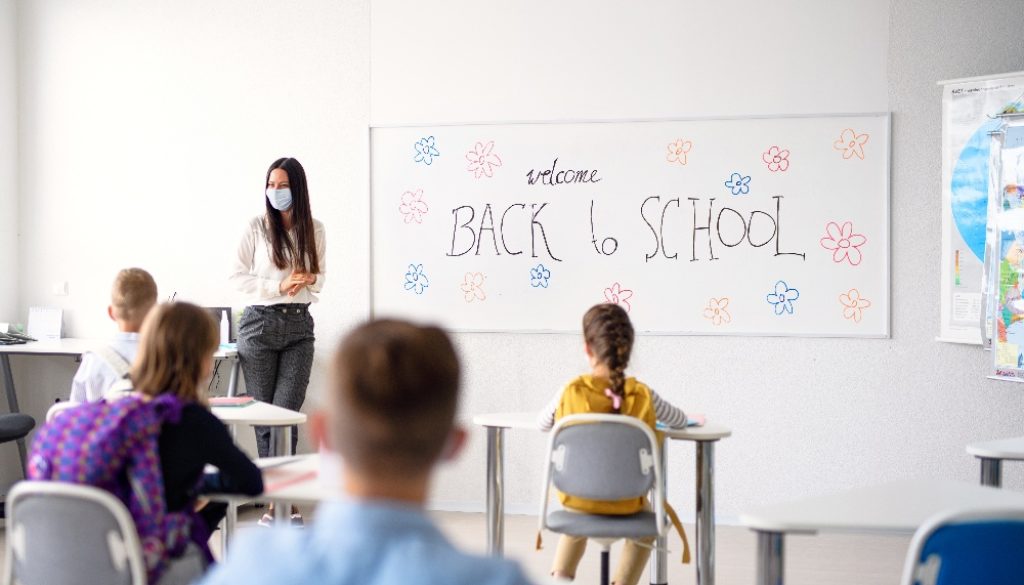Les enseignants doivent-ils être traités comme des travailleurs de première ligne ?
As the summer winds down, educators across the country are grappling with how they will begin the 2020-2021 academic school year amid our current public health crisis. Some school districts are taking a hybrid approach, others are staying completely remote, and for schools in low-risk areas they are welcoming students back into the classrooms with strict social distancing and hygiene protocols in place to curb the spread of the coronavirus.
Reopening schools has proven to be unpredictable and stressful, with the new reality bringing a variety of challenges for educators and school leaders, including what procedures and equipment need to be in place to keep schools safe and how that be funded, according to a recent Washington Post article. The biggest challenge for schools is ensuring the safety of both the students and school staff.
Teachers across the United States are rightfully worried about getting back into the classroom. There have been spikes of COVID-19 cases around the country, and studies have proven children can spread the virus just as much as adults can. Some schools have already opened and have quickly seen positive tests of the coronavirus causing large groups – who were in contact with an infected individual – to go get tested themselves and return home to quarantine.
Although teachers are putting themselves at risk to teach today’s youth, they are not currently considered essential workers – or front-line workers – during the pandemic.
What is a Front-Line or Essential Worker?
The Washington Post explains that according to the National Conference of State Legislatures, sectors deemed “essential” by federal and/or state guidelines include:
- Energy
- Childcare
- Water and wastewater
- Agriculture and food production
- Critical retail, such as grocery stores, hardware stores, and mechanics
- Critical trades, such as construction workers, electricians, plumbers, etc.
- Transportation
- Some social service organizations
Although at least 28 states labeled childcare services and providers as essential workers, teachers are not. Other countries, like Britain, considered teachers and social workers as front-line workers when schools shut down. Some stayed open for vulnerable students and for children whose parents had essential jobs, according to Occupational Health & Safety.
The Economic Policy Institute (EPI) provides some of the below facts about essential workers:
- Women make up the majority of essential workers in health care (76 percent) and government and community-based services (73 percent).
- Men make up the majority of essential workers in the energy sector (96 percent), water and wastewater management (91 percent), and critical manufacturing (88 percent).
- People of color make up the majority of essential workers in industrial, commercial, residential facilities, and services (53 percent).
- Nearly 70 percent of essential workers do not have a college degree. Three in 10 essential workers have some college (30 percent) or a high school diploma (29 percent). One in 10 have less than a high school diploma.
Why Many Argue Teachers Should Be Considered Essential Workers
When the pandemic first hit teachers did everything in their power to connect with their students remotely. Many kids rely on school for basic needs such as meals, safe places to play, technology tools, and access to psycho-social and health services, which were all impacted when schools shut their doors and sent kids home.
For many, a hybrid or remote education model comes with severe problems such as no access to the internet or limited childcare options for those whose parents or guardians have to go to work and leave their children home.

Teachers and school staff are likely under a great deal of pressure and stress, especially if they are at-risk or live with immunocompromised or elderly people. Again, studies have shown that children can spread the coronavirus just as easily as adults, which increases the risk for teachers as they’ll be exposed regularly.
As schools reopen, teachers and school staff will become the new front line to ensure student safety during the pandemic. The Washington Post article argues that for teachers to succeed people must stop treating them as peripheral to this crisis and consider educators essential workers.
So, what would this mean?
Front-line workers receive priority access to COVID-19 testing, personal protective equipment (PPE), and to a vaccine when it becomes available. Because teachers are in close contact with their students – who may be difficult to keep to the strict hygienic and social distancing protocols – they are more likely to contract the coronavirus in comparison to those who can work from the safety of their homes.
Teachers should also be heavily involved with planning and reopening schools by providing guidance and health information to help adapt solutions to the specific realities of each classroom. Additionally, schools must receive the proper funding to buy PPE, hand sanitizers, disinfectants, and other vital tools to create a safe school environment. Teachers who are at high-risk from COVID-19 should be allowed to stay home and if possible, teach remotely.
Educators are doing all they can to protect students and continue to keep them learning. We must do our best to prioritize the safety of teachers and school staff who are putting themselves at risk to help our countries kids.
The author of the cited Washington Post article, Valerie Strauss, makes an incredible point; “The challenge is enormous and complex, but the calculus is simple: We can’t invest in our children’s futures if we ignore the well-being of their teachers.”





